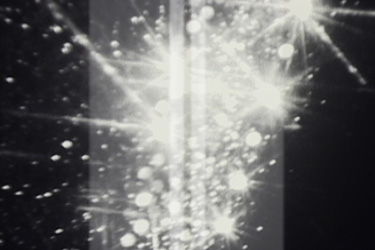Marina Rosenfeld, Still from WHITE LINES, 2005.
Marina Rosenfeld, Teenage Lontano
Born 1968 in New York, New York; lives in New York, New York
Marina Rosenfeld’s composed musical performances deconstruct the notion that visual and sonic artistic practices are separate by placing equal conceptual importance on every aspect of her orchestrated situations. Like other experimental artist-musicians, including Christian Marclay, Yoko Ono, and Laurie Anderson, Rosenfeld’s avant-garde work challenges accepted musical norms. Rosenfeld’s concerns lie particularly in a clean sensory aesthetic that deemphasizes attention on the individual to highlight the dynamic relationship between the performers, orchestra, audience, and the music itself. This methodical approach to live music performance is integral to her efforts to define a sound that encompasses, but is not limited to, femininity.
Rosenfeld’s sonic palette varies widely, though her interest in music’s potential to level social inequalities underlies her compositional and visual arrangements. Created for the 2002 Whitney Biennial, Delusional Situation (2002) featured a multispeaker installation of a recording based on the artist’s live performance as a turntablist spinning “dub plates”— handmade acetate records—of prior live performances, metaphorically recycling sound. An artist who creates, directs, and participates in her experimental orchestras, Rosenfeld also recruits untrained musicians as a way to multiply improvisational elements in her practice and to highlight the social interaction inherent to musicmaking. A row of seventeen women used nail polish bottles to play floor-bound electric guitars in sheer frost orchestra (1994– ), recalling early punk bands the Slits and Ut, whose experimental use of instruments became feminist statements. For the 2005 Tate Modern performance of emotional orchestra (2003), female participants costumed in street clothes accented by single silver sleeves bowed a variety of stringed instruments; their actions were cued by a form of graphic notation realized by Rosenfeld as an animation in which a pair of large white stripes of fluctuating width and opacity bisect Super 8 footage of pastoral scenes.
For Teenage Lontano (2007), her sound installation and performance for the 2008 Whitney Biennial, Rosenfeld has recorded a choir of twenty teenagers “covering” György Ligeti’s modernist piece Lontano (1967), to be heard through mp3 players and headphones. By juxtaposing a high modern composition and the teen-vocal sound associated with pop music, Rosenfeld argues that variant musical languages share common aural territory. To make the initial recording, each singer accompanied an individualized audio score, creating complex tone clusters that Rosenfeld has renegotiated into a larger composition of pop song–length segments. Certain sections are rich with choral harmony, while others dissipate into abstract, isolated sound fragments punctuated by cello, percussion, bass, and electronics reminiscent of early modern analog synthesizer sounds. Listening to Teenage Lontano evokes space-age, multilayered imagery that counterbalances the austere “stage” dominated by twenty headphones placed on twenty aligned microphone stands. As in Rosenfeld’s other installations, here individual elements, though radically different or in apparent opposition, are forged into a transformative encounter that urges its audience to use as many senses as possible as they experience it. TRINIE DALTON
Marina Rosenfeld, Still from WHITE LINES, 2005. Super 8 film transferred to video with digital animation, color, silent; 30 min

























